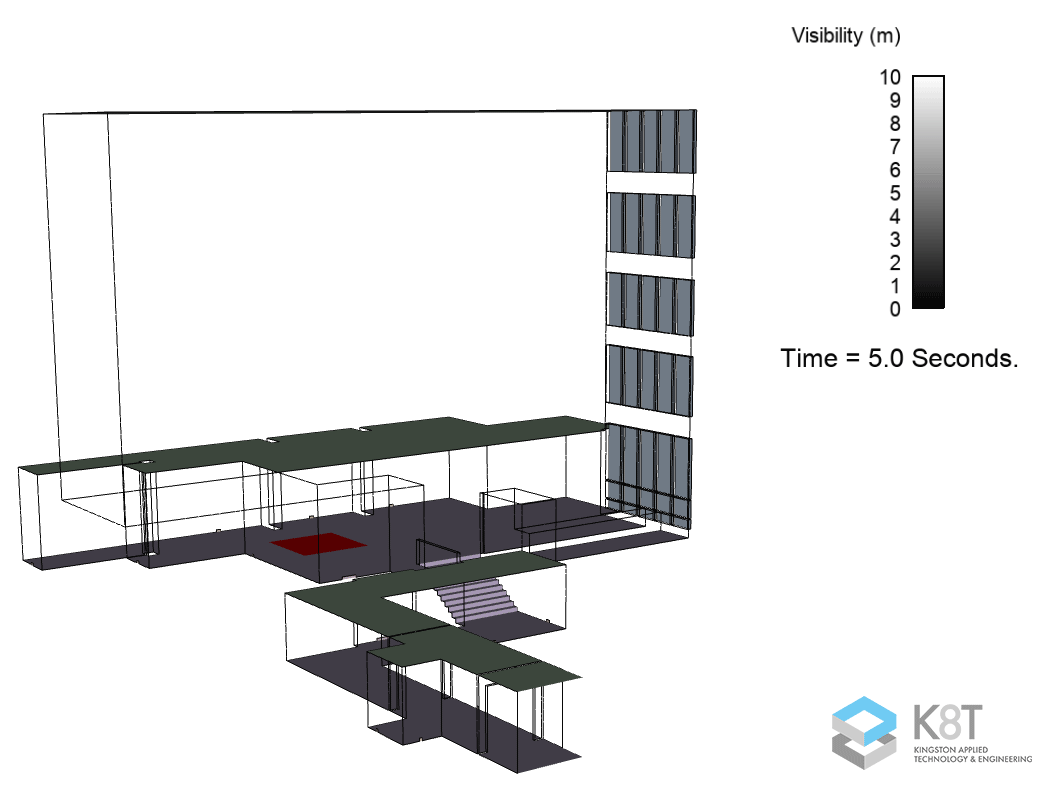
FIRE AND SMOKE VENTILATION
FIRE AND SMOKE VENTILATION ANALYSIS
From residential, to offices and commercial, to atrium spaces, the ventilation system design is essential to ensure the safety of the building occupants.
Computational Fluid Dynamics (CFD) can be used to analyse the performance of a Smoke Ventilation systems to be compliant with the requirements set out in Building Standards and British Standards. We use two different CFD codes to evaluate systems - Ansys Fluent and FDS.

RESIDENTIAL
Life safety systems are a crucial part of any development. Through using CFD the ventilation system can be evaluated to ensure a safe and compliant system that protects occupants during means of escape and firefighters after evacuations have occurred using tenability criteria outlined within British Standards and relevant guidelines for residential environments.

OFFCE
Evaluation of the ventilation system during an office fire. With open plan offices becoming more and more common, it is essential to ensure safe and complaint system that can protect occupants during evacuation and for firefighting.

ATRIUM
An atrium provided an interactive and inviting space along with bringing light into a wide area of offices and residential spaces. As these become more common the interaction of the atrium with ventilation system are vital to ensure that the space does not come become overwhelmed.

OTHER COMMERCIAL
There are a wide range of sectors that need to ensure that there are safe and compliant ventilation systems to ensure that the escape of occupants are not impeded. With a large number of people concentrated in a single space shopping centres and theatres are examples of where complex system need evaluation.

DETERMINISTIC
ANALYSIS
With a large number of people concentrated in a single space and the use of large open plan layouts becoming more popular, the evaluation of the smoke ventilation system is vital to ensure compliance and the safety of the occupants.
CFD analysis of such systems can provide detailed analysis of a variety of office, retail and residential spaces. Performance criteria for such analysis can vary, sensitivity studies and comparative analysis are two methods of establishing compliance of Mechanical Smoke Ventilation Systems (MSVS).
COMPARITIVE ANALYSIS
Depending of the system set up, a comparative analysis can be provided which can determine the performance of the Mechanical Smoke Ventilation System (MSVS) when compared to a legislative complaint BRE natural smoke shaft.
This method requires the proposed mechanical system to perform to an equivalent or greater level than the code compliant system. With the comparative analysis, two simulations are undertaken. The first being the mechanical ventilation syustem, the second being the same geometry but with a compliant natural shaft instead of the mechanical system. The two simulations can then be compared to evaluate the performance of the MSVS.


SENSITIVITY ANALYSIS
With a large number of people concentrated in a single space and the use of large open plan layouts becoming more popular, the evaluation of the smoke ventilation system is vital to ensure compliance and the safety of the occupants.
CFD analysis of such systems when can provide detailed analysis of a variety of office sizes, from small office rooms to large scale open plan offices. Performance criteria for such analysis can vary, sensitivity studies and comparative analysis are two methods of establishing compliance of Mechanical Smoke Ventilation Systems (MSVS).
COMPUTATIONAL FLUID DYNAMICS SOFTWARE
Therer are many different types of Computational Fluid Dynamics (CFD) code. At K8T we use two main types of CFD code to analyse the compliance of Mechanical Smoke Ventilation Systems (MSVS), FDS from NIST and Fluent from Ansys. The specification for the software can be decided by the scale or complexity of the model.
Throughout the project updates and assistance with understanding can be provided to ensure the smooth running of the project.

FIRE DYNAMICS SIMULATOR (FDS)
Fire Dynamic Simulator (FDS) is a open source computational fluid dynamics (CFD) modeller which is designed to model thermally driven, low velocity fluid flows. The software is developed by the National Institute of Standards and Technology (NIST) and is commonly used in academic research studies but has found a wider use within the built environment/engineering sectors.
ANSYS FLUENT
Ansys Fluent is a commercially available computational fluid dynamics (CFD) modeller that allows a broad range of physical modelling. Fluent has the capability to model flow, turbulence, heat transfer and other reactions that allow airflow and combustion modelling. Through the use of high-performance computing (HPC) large scale CFD simulations can be undertaken and provides a high fidelity for the physics being modelled.



FEATURED PROJECTS
From large scale atrium spaces to residential apartments, the evaluation the the smoke ventilation system is essential for the safety of the building occupants, CFD analysis can provide valuable insight into the performance of the ventilation system as well as meeting regulatory requirements.
See some of our previous projects to better understand the services we can provide
.png)